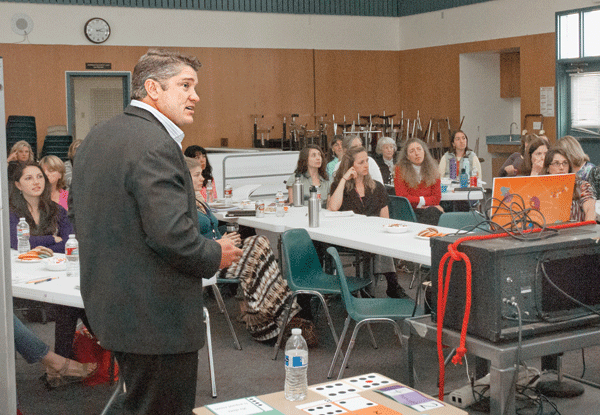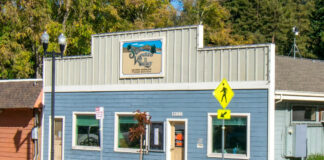How many is 10 sets of four? Obviously, the answer is 40.
Then, how many is five sets of four?
For those who answered 20, that is the correct answer, but not the best answer, according to James Burnett, the senior writer and founder of Stepping Stones, a new math curriculum by his company Origo Education, catered to national Common Core standards.
The best answer, Burnett said, is “half of 10 sets of four.”
This concept is an example of the way students are learning to think at San Lorenzo Valley Elementary School as part of the implementation of the Common Core.
Burnett visited SLE and the Santa Cruz County Office of Education on Wednesday, Oct. 9 to talk about Common Core standards and how his company’s new kindergarten through fifth grade math curriculum, Stepping Stones, teaches conceptual learning, rather than memorization.
SLE, this year, is a pilot school for the curriculum and Burnett visited the campus on Wednesday to answer questions the teachers had and explain the thinking behind the curriculum. Within his presentation he identified three problems that the country faces.
“Teaching practices have remained the same for the past 100 years,” he said. “The teacher shows the procedure; kids practice it. (The Common Core) is trying to change that.”
Additionally, Burnett said, the U.S. math curriculum has consisted of too many low-level tasks where students are taught what to think, rather than how to think through a problem.
These two issues have led to a third issue: U.S. students are ranked 25th among their peers around the world in math skills, and the rank is falling, as 35 percent of 8th graders nationwide do not perform to an 8th grade level in math.
Thus, the adoption of the Common Core, which uses more visual models, different language to describe mathematics and more varied ways to solve problems.
“We want the kids to be thinking,” Burnett said.
Burnett built the curriculum from the ground-up specifically tailored to the Common Core goals and standards. To his knowledge, it’s the only curriculum that has been built to Common Core standards without any guides to adopt an existing curriculum to the standards.
“We don’t just address content, but the intent of the Common Core,” he said.
Burnett’s visit was facilitated by Hollie Becker, the district’s first-year Assistant Superintendent of Instructional Services. Becker met Burnett last year during a conference in Chicago and was impressed with the curriculum.
“I was just really surprised by what the program offers,” Becker said.
She liked the many built-in videos and assessments, and was impressed how all the teachers are able to access lessons from kindergarten through 5th grade, rather than just their own grade level. She said the district is piloting the program this year, and will decide if they want to continue with it next year.
Fourth grade teacher Jamie Herman attended Burnett’s seminar.
“It’s nice to be able to ask questions and get responses and to see where they’re coming from,” she said.
Herman said understanding the reasons the curriculum is ordered the way it is has been hard at times. Additionally, she’s had to change the way questions are asked to incorporate Common Core thinking.
“It’s a big adjustment,” Herman said. “It’s a new way of approaching their thinking.”
Burnett told teachers “change is hard,” and that they would start seeing a change in students thinking in six or seven months.
– To comment, e-mail editor Peter Burke at pe***@*********er.com, call 438-2500 or post a comment at www.pressbanner.com.













